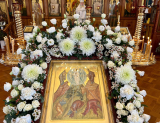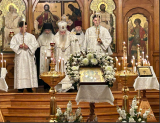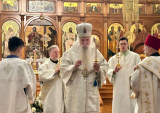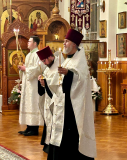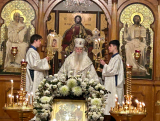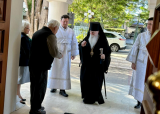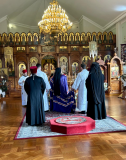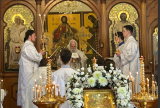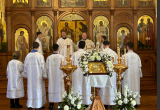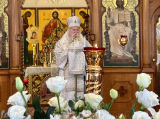25 Aug 23: His Grace Bishop George of Sydney Australia and New Zealand celebrated the feast of Holy Transfiguration at Sts Peter and Paul Cathedral
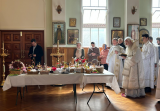 On Friday, 18 August and Saturday, 19 August 2023, His Grace Bishop George celebrated the services for the great feast of Holy Transfiguration at Sts Peter and Paul Cathedral, Strathfield. Co-serving with Bishop George were the Cathedral clergy and Abbot Cyprian from Holy Trinity Monastery, Jordanville NY, USA.
On Friday, 18 August and Saturday, 19 August 2023, His Grace Bishop George celebrated the services for the great feast of Holy Transfiguration at Sts Peter and Paul Cathedral, Strathfield. Co-serving with Bishop George were the Cathedral clergy and Abbot Cyprian from Holy Trinity Monastery, Jordanville NY, USA.
Following the Divine Liturgy, Bishop George blessed the fruit.
It is the tradition of the Day of Transfiguration to consecrate grapes, apples and other fruit after the Divine Liturgy. The custom of bringing fruit to the temple for consecration originates in the Old Testament time (Gen 4:2-4; Ex 13:12-13; Num 15:19-21; Deut 8:10-14). The Apostles brought this tradition to the Church of the New Testament (1 Cor 16:1-2). Instruction regarding bringing fruit to temple is found in the Third Rule of the Apostolic Canon, the earliest collection of ecclesiastic laws (canons), known since the second century. In Greece, August is the month of ripeness of fruit, mostly grapes and new ears of corn. Since old time, the faithful have been bringing them to temple for consecration and as Thanksgiving to God. St. John Chrysostom wrote, “Plowman receives fruit from the earth not so much for his labour and diligence, as out of goodness of God Who grows this fruit, because neither is he that planteth anything, neither he that watereth; but God that giveth the increase.”
Grapes are brought to temple because they are directly related to the Eucharistic sacrament; that is why in the prayer for consecration of grapes the priest says, “Bless, Lord, this new fruit of vine which reached ripeness because Thou kindly provided good weather, drops of rain and stillness. Let eating this fruit of vine make us joyful. And give us the honor of offering this fruit to Thee, as the gift of purging of sins, altogether with the Holy Body of Thy Christ.”
In the first centuries of Christianity, the faithful brought forth to the temple the fruit and crops of the new harvest: bread, wine, oil, incense, wax, honey etc. Of all these offerings, only bread, wine, incense, oil and wax were taken to the altar, while the rest was used for the needs of the clergy and the poor whom the church was caring for. These offerings were to express gratitude to God for all goods, but at the same time help servants of God and people in need. Until today, consecration of bread and wine, eggs and milk and other food has been kept in consecration of artos in the church and meals at home on Easter. Consecration of flowers and tree branches is performed now on Palm Sunday, the days of the Holy Trinity and Exaltation of the Cross, and on Sunday of the week of the Veneration of the Cross. Rice with rasins and honey are used as offerings in services for the dead and remembrance repast. Prosphoros are brought forth for proskomide everywhere even today.

 Sts Cyril and Methodius Orthodox Institute
Sts Cyril and Methodius Orthodox Institute
